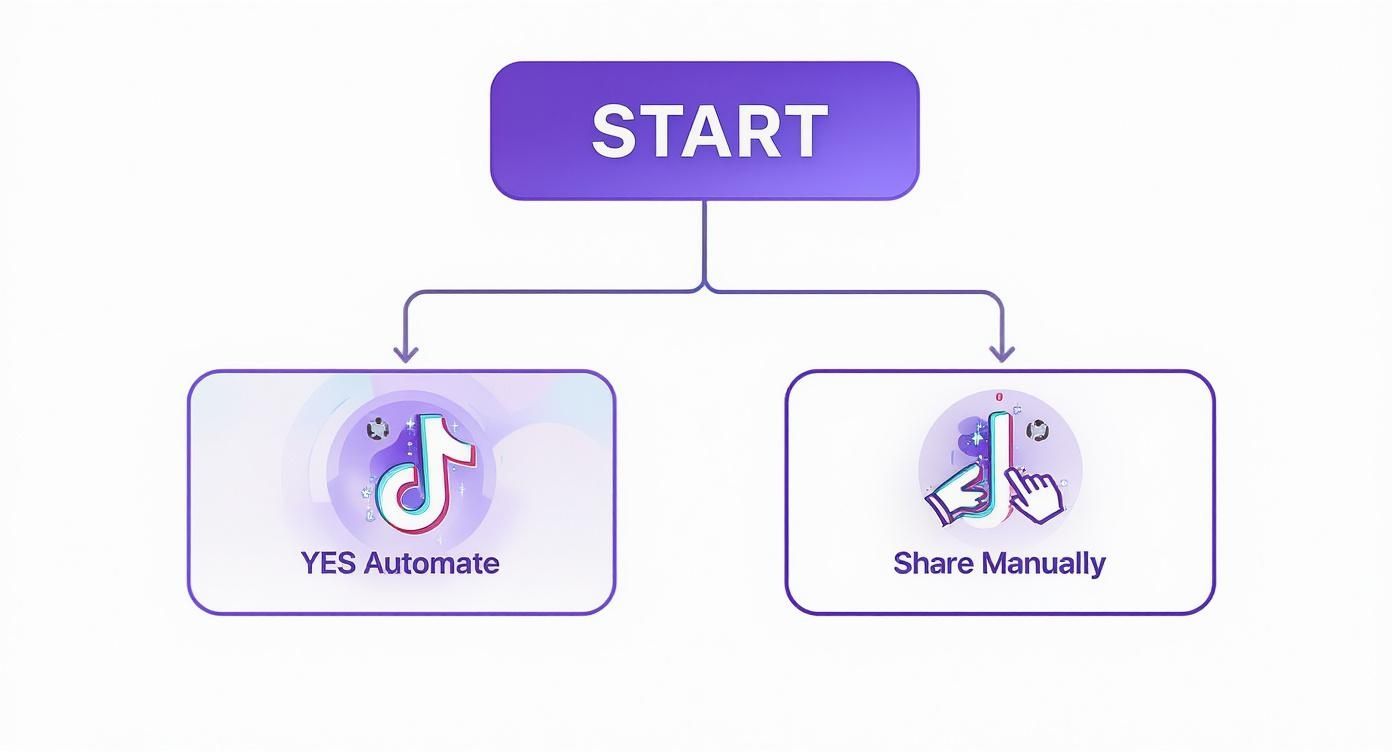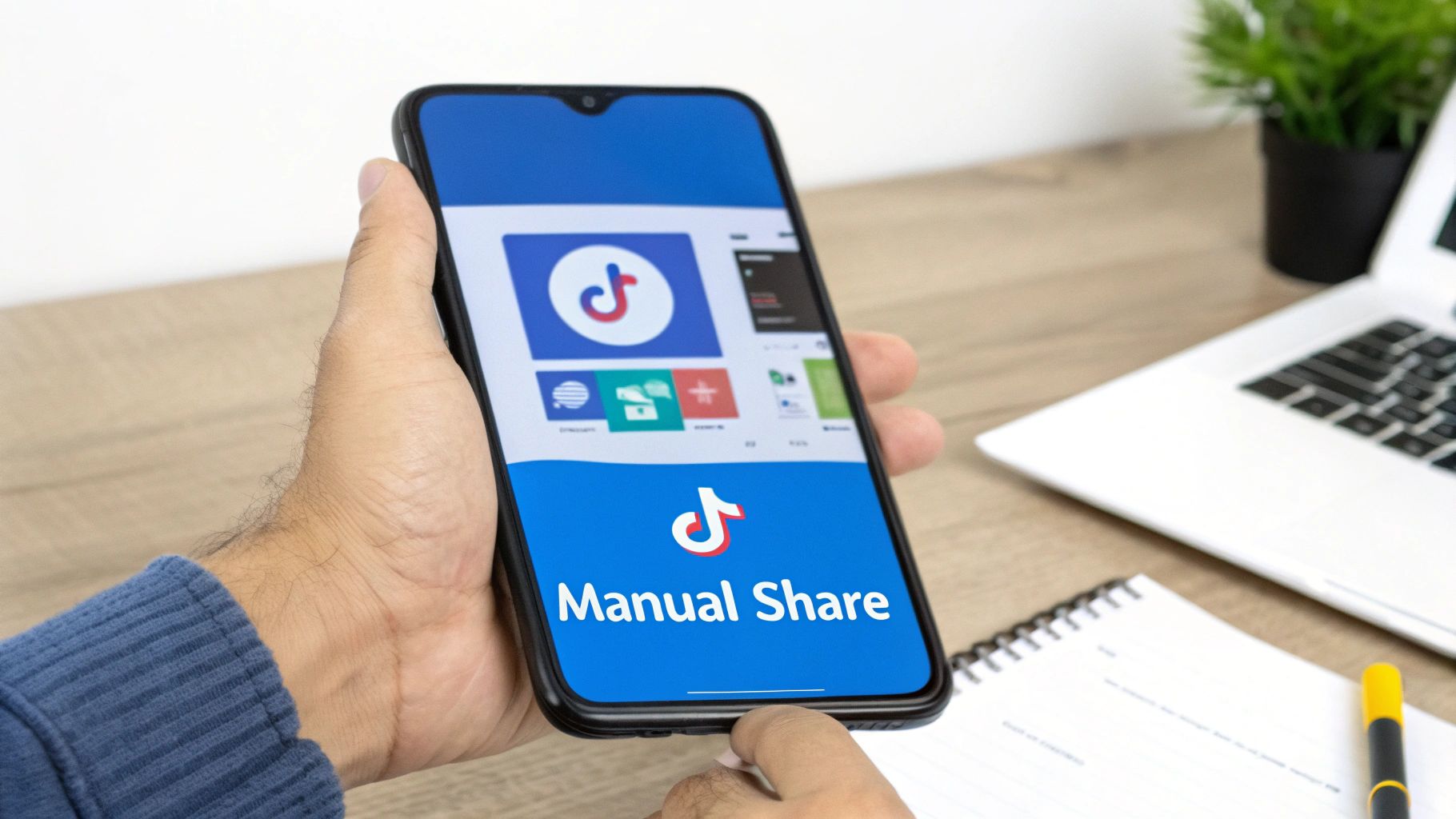If you're looking for the absolute best way to share your TikTok videos on Facebook, let's cut right to the chase: automate it with a tool like PostOnce. It automatically shares your new TikToks the moment you post them, without you having to lift a finger, making it the most efficient and hands-off method available.
PostOnce: The Direct Solution for Sharing TikToks to Facebook
The primary reason you're searching for "how to share TikTok to Facebook" is likely because the manual process is tedious and time-consuming. You want a seamless way to get your content in front of a larger audience without the repetitive cycle of downloading, re-uploading, and rewriting captions for every single video. This is the exact problem PostOnce solves. It acts as a bridge between your TikTok and Facebook accounts, automatically crossposting your content so you can focus on creating, not just sharing. By setting up a simple workflow, you directly address the core challenge of multi-platform content distribution, ensuring your videos reach your Facebook audience consistently and effortlessly.
The Smartest Way to Share TikToks on Facebook
Sure, TikTok gives you a "share" button. It works fine if you're just sharing a video here and there. But if you're a creator or a brand trying to build a consistent presence on both platforms, manually sharing every single video gets old, fast. It's a tedious, repetitive chore that eats into your creative time.
This is where an automated workflow really shines. Instead of getting bogged down in the cycle of downloading, uploading, and rewriting captions, a dedicated crossposting service does the heavy lifting for you. You can get back to what you do best—making great content—while your distribution takes care of itself.
By sharing your TikToks to Facebook, you’re tapping into the best of both worlds. You get the viral, high-energy format of TikTok and the massive, diverse audience that Facebook offers. It’s a powerful combination for maximizing your reach.
Why Automation Is a No-Brainer
Opting for automation over manually sharing every video isn't just about convenience; it delivers some serious advantages.
- It saves a ton of time. Seriously, think about all the minutes you'll get back by not having to jump between apps for every single post.
- It keeps you consistent. Your content shows up on Facebook like clockwork, which is crucial for keeping your audience engaged and your momentum going.
- It protects your video quality. You can sidestep the frustrating compression issues and quality loss that sometimes happen when you download and re-upload videos yourself.
A service like PostOnce is built to handle exactly this, making your social media workflow far more effective.
For a more detailed walkthrough, you can check out our guide on connecting TikTok to Facebook. And if you want to stay ahead of the curve on social media trends, it's always a good idea to explore the BrandiTok blog for additional insights.
How Should You Share Your TikTok on Facebook?
Before you push your next TikTok masterpiece over to Facebook, it’s worth thinking about how you’re going to do it. The method you choose has a real impact on everything from video quality to how the Facebook algorithm sees your content. Are you aiming for speed, a clean look without a watermark, or getting the most eyeballs on your post?
Your main manual options boil down to sharing directly from the TikTok app, just grabbing the link, or downloading the video to upload it fresh. Each has its pros and cons. The direct share is lightning-fast but can look a little clunky. Re-uploading it as a native video is what the algorithm loves, but it's more work.
This flowchart breaks down the decision pretty clearly—it's a choice between putting in the manual effort or using a tool to automate it.

Ultimately, it comes down to how much time you want to spend sharing your content.
Comparing TikTok to Facebook Sharing Methods
Let's get into the nitty-gritty of each manual sharing method. Think of this table as your cheat sheet for deciding which approach fits your needs for any given video.
| Sharing Method | Best For | Pros | Cons |
|---|---|---|---|
| Direct Share from App | Quickly sharing a video to your personal profile or in a message with one tap. | The fastest and most straightforward way to share. No extra steps. | Creates a link preview post on Facebook, which often gets lower engagement. Looks less professional. |
| Copying the Link | When you want to craft a custom Facebook post but don't mind it being a link preview. | More control over the caption and post text than a direct share. | Still just a link. Facebook’s preview can be inconsistent, and it won't perform like a native video. |
| Download and Re-upload | Getting maximum reach and engagement, especially for Reels or your Facebook Page. | Uploaded as a native video, which the Facebook algorithm heavily favors. Higher potential for organic reach. | Takes the most time. The video will have a TikTok watermark unless you use a third-party tool to remove it. |
As you can see, the best method really depends on your goal. If you just want to show a funny video to a friend, copying the link is fine. But if you're a creator trying to grow your audience, downloading and re-uploading is almost always the better choice.
The strategy of reusing your content on different platforms has a name: crossposting. It's all about working smarter, not harder, to expand your reach. If you want to go deeper, we have a whole guide that explains what is crossposting and why it’s so effective.
Sharing Your TikToks Manually

While automation tools like PostOnce are fantastic for streamlining your content strategy, sometimes you just need to share a single video quickly. Knowing the manual methods gives you the flexibility to post on the fly, and thankfully, TikTok makes it pretty straightforward.
The platforms are built to play nice with each other, which is a huge win for creators. Cross-posting from TikTok is one of the best ways to get your content in front of a massive new audience on Facebook. We're talking about a user base projected to hit over 3 billion people by 2025—a number that's hard to ignore. If you're curious about the numbers, Buffer's latest report on Facebook statistics breaks it all down.
So, let's get into the three main ways you can do this yourself.
The Easiest Way: Use the Direct Share Button
This is your go-to for speed and simplicity. If you just want to get a video onto your personal feed or into a group chat, this is the quickest route.
- First, open up TikTok and find the video you want to share. This can be one of your own or one from another creator.
- Look for the "Share" icon on the right side of the screen—it looks like a little arrow pointing right. Tap it.
- A menu will pop up with a bunch of app icons. Just find the "Facebook" icon and give it a tap.
- Facebook will then ask you where you want to post it: on your Feed, in your Story, or to a specific group. Make your choice, add a quick caption if you want, and hit "Post." You're done.
A quick heads-up: this method usually posts a link preview on Facebook. From my experience, these don't get as much love from the algorithm as native video uploads. For better performance, the next method is a step up.
The Link-Copier Method for a Custom Touch
If you want a bit more control over your Facebook post's presentation, simply copying the video link is a solid choice. It lets you craft a more compelling caption and frame the video exactly how you want.
You’ll start the same way as before: hit the "Share" arrow on the TikTok video. But this time, instead of choosing the Facebook icon, select "Copy Link."
With the link copied, head over to the Facebook app. Start a new post, paste the link into the text field, and wait a second for the video preview to load. Now you can write your own introduction to get people interested before they click.
The Pro Move: Download and Upload Natively
For any serious creator or brand, this is the gold standard. Downloading your TikTok and uploading it directly to Facebook as a new piece of content is the best way to maximize your reach. Why? Because the Facebook algorithm heavily favors native video, especially Reels, often rewarding it with much higher engagement.
Here’s how it works:
- Save the Video: From the TikTok video, tap the "Share" arrow, then select "Save video." This downloads a copy straight to your phone's camera roll, usually with the TikTok watermark.
- Upload to Facebook: Open up Facebook and decide what kind of post you want to make. You can do a standard Feed post, a Story, or a Reel.
- Go for Reels: For the best possible visibility, I always recommend choosing the "Reel" option. Select the video you just saved, add your caption and hashtags, make any final edits, and publish.
This little bit of extra effort signals to Facebook that you're uploading fresh, original content, giving you the best shot at reaching a whole new audience.
Automate Your Workflow with PostOnce
Let's be honest, manually sharing every single TikTok you create is a huge time suck. It pulls you away from what you should be doing: creating more great content. If you're serious about growing on both platforms, you need to automate.
That’s where a tool like PostOnce comes in. It’s built specifically to solve this problem by automatically sharing your TikToks straight to Facebook.
Instead of getting stuck in that endless loop of downloading, re-uploading, and re-writing captions, you just set up a simple workflow. Once you connect your accounts, every new TikTok you post can instantly appear on your Facebook profile, page, or even in a group. It’s less about saving a few minutes here and there and more about building a reliable system for getting your content in front of more people.
A Smarter Way to Share TikToks
The real challenge isn't just figuring out how to get one video from TikTok to Facebook. It's about creating a process that you can stick with long-term without burning out. By taking the manual work out of the equation, PostOnce ensures your Facebook audience never misses your latest video, even when you're busy.
This screenshot gives you a peek at how you can set up these automated workflows by connecting different accounts.
You just tell it your source (TikTok) and your destination (Facebook), and it handles the rest. It's a true "set it and forget it" system.
The advantages go way beyond just convenience.
- Maintain Quality: Automation helps you sidestep the weird compression issues that sometimes happen when you manually download and re-upload videos. Your content looks just as good on Facebook as it did on TikTok.
- Customize Content: You can tweak your captions for your Facebook audience right from the tool.
- Schedule for Impact: Post at the perfect time for maximum engagement on Facebook, without having to do it live.
Automating your cross-posting isn't just a shortcut; it's a strategic advantage. It frees you up to focus on creating great content while your distribution runs seamlessly in the background, keeping your audience engaged on all platforms.
A tool like PostOnce lets you build powerful workflows that keep your content engine running smoothly. To see exactly how it works, you can explore the different ways to crosspost your social media content automatically. This one small change can completely transform how you manage your social media, saving you a ton of time while expanding your reach.
Optimizing Shared Videos for Facebook Engagement

Getting your TikTok video onto Facebook is a great first step, but it’s really only half the job. If you want your content to actually perform well, you need to think like a Facebook user and play by the rules of its algorithm. Just dumping a link or a raw video file onto your feed can make your content feel out of place and seriously limit its reach.
The first thing to tackle is the caption. What works on TikTok—with its inside jokes and specific trends—can fall completely flat on Facebook. Take a minute to write a fresh description that feels native to the platform. I find that asking a direct question or creating a conversation starter is a fantastic way to get comments rolling in.
Next up, your hashtags need a complete overhaul. Those trending TikTok tags are perfect for the For You Page, but they rarely carry the same weight on Facebook. Do a little digging to find hashtags that are relevant and popular within the Facebook community. This simple tweak can make a world of difference in how many new people discover your video.
For a deeper dive, check out our guide on https://postonce.to/blog/how-to-use-hashtags-on-facebook.
Format and Timing Matter
The way you post your video is just as important as the video itself. While a standard feed post is okay, you’ll almost always get better results by uploading it as a Facebook Reel. Facebook’s algorithm is heavily pushing Reels right now, which means more organic reach for you.
Also, think about when you post. Dropping your video when your Facebook audience is most active gives it the best shot at gaining immediate traction.
Key Takeaway: A natively uploaded video will almost always outperform a shared link from another platform. Taking the extra minute to download your video from TikTok and upload it directly to Facebook tells the algorithm you're adding fresh, valuable content.
Sharing TikToks on Facebook became a go-to strategy as short-form video exploded in popularity. The data supports this move; you can tap into Facebook’s high 5.07% average engagement rate, which sometimes leads to even better interaction than on TikTok itself.
To really nail your strategy, it helps to start by understanding TikTok engagement rates. Knowing how your content performs on its home turf gives you a baseline for what to expect and how to improve when you share it elsewhere.
Common Questions About Sharing TikToks to Facebook
As you start sharing content between platforms, a few common questions always seem to pop up. Getting these sorted out will save you a ton of headaches and make sure your TikToks get the attention they deserve over on Facebook.
Can I Share to a Facebook Page?
Absolutely. You can share your TikTok video to a personal profile, a Facebook Page you manage, or even a Group.
If you use the built-in share option from TikTok, Facebook will ask you where you want the video to go. For more control, especially for business pages, I usually recommend downloading the video first and then uploading it manually right on your Facebook Page.
Will My TikTok Automatically Become a Facebook Reel?
Nope, not usually. Hitting the direct share button from the TikTok app typically creates a standard video post on your Facebook feed.
To make sure it becomes a Facebook Reel (which is what you want for the best reach), you need to take an extra step. Download the video from TikTok, then open your Facebook app and upload it specifically through the "Reels" creator.
Does Facebook Penalize TikTok Watermarks?
This is the big question. While Meta doesn't have an official rule that says "we penalize TikTok watermarks," their algorithm definitely prefers native content. In my experience, a video with a rival platform's watermark often gets slightly less reach than a clean version uploaded directly.
For a deeper understanding of platform-specific nuances, it's helpful to review the best practices for crossposting on social media, as each network has its own preferences.
What's the Best Format to Share?
For the biggest impact and best chance of going viral, posting as a Facebook Reel is almost always the answer. The algorithm is pushing Reels hard right now.
That said, other formats have their place. Sharing to Facebook Stories is great for more casual, behind-the-scenes content that disappears in 24 hours. A standard video post is still a good choice if you want to write a longer, more detailed caption to go with it.
Ready to stop worrying about the details and just get your content everywhere? PostOnce automates the entire process, sharing your TikToks to Facebook and other platforms instantly. Start automating your workflow with PostOnce today.